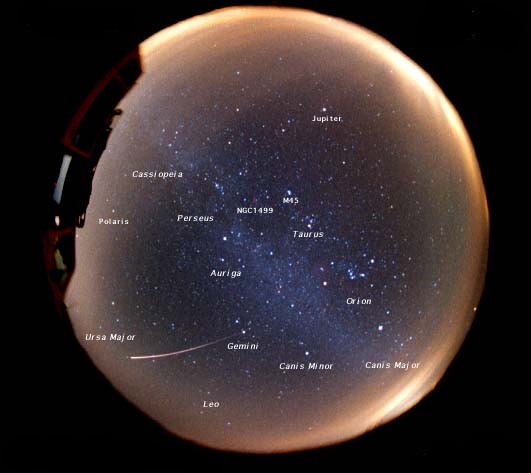[/caption]
One of the best night sky events of the year is on tap: The Geminid Meteor shower. According to the Royal Astronomical Society, the evening of December 13 and the morning of December 14, skywatchers across the northern hemisphere could see up to 100 “shooting stars” or meteors each hour. This number is what will be seen at the peak of activity, but if conditions are clear you can definitely take the time to observe any time between Sunday night, Dec. 12 to Wednesday morning, Dec. 15.
You can also participate and share in the event on Twitter, with the #Meteorwatch crew.
Of course, meteors are the result of small particles entering the Earth’s atmosphere at high speed, burning up and super-heating the air around them, which shines as a characteristic short-lived streak of light. In this case the debris is associated with the asteroidal object 3200 Phaethon, which many astronomers believe to be an extinct comet.
The meteors appear to originate from a ‘radiant’ in the constellation of Gemini, and so the name Geminid.
For US skywatchers, Sky & Telescope predicts that under a clear, dark sky, one or two shooting stars per
minute will likely be seen from about 11 p.m. local time Monday until dawn Tuesday morning. If you live under the artificial skyglow of light pollution the numbers will be less, but the brightest meteors will still shine through.
For European, and particularly British observers, the RAS says by 0200 GMT on December 14, the radiant will be almost overhead in the UK, making it the best time to see the Geminids. By that time the first quarter Moon will have set so the prospects for a good view of the shower are excellent.
Meteors in the Geminid shower are less well known, probably because the weather in December is less reliable. But those who brave the cold can be rewarded with a fine view. In comparison with other showers, Geminid meteors travel fairly slowly, at around 35 km (22 miles) per second, are bright and have a yellowish hue, making them distinct and easy to spot.
To watch for meteors, all you need are your eyes. Find a dark spot with an open view of the sky and no glary lights nearby. Bundle up as warmly. “Go out late in the evening, lie back, and gaze up into the stars,” says Sky & Telescope senior editor Alan MacRobert. “Relax, be patient, and let your eyes
adapt to the dark. The best direction to watch is wherever your sky is darkest, probably straight up.”
As with most astronomical events, the best place to see meteors is at dark sites away from the light pollution of towns and cities. You can also check with astronomy clubs or science museums if they are hosting any viewing events.
The Geminids will also feature in a Twitter event, called Meteorwatch, where observers can post their text, images and videos to share them with other observers (and also for those having less favorable locations. Anyone with Internet access can join in by following @virtualastro and the #meteorwatch hashtag on Twitter.
Sources: RAS, Sky & Telescope,


If my luck holds I may be able to see them here in the UK. We are forecast frost for Sunday/Monday night & frosts usually come with clear skies therefore …
The skies have been clear these last two weeks, hope it lasts for this.